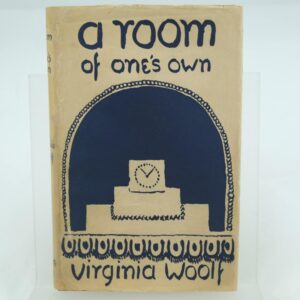A rare publisher’s tale:
 It is not often that the publishers are featured in the consideration of influences to literary movements. However, The Hogarth Press has a unique place in the history and development of modernism and literature of the twentieth century.
It is not often that the publishers are featured in the consideration of influences to literary movements. However, The Hogarth Press has a unique place in the history and development of modernism and literature of the twentieth century.
The Hogarth Press was born out of an ideal to provide a hobby for a writer with poor mental health who was sensitive to criticism from demanding publishers. The author in question was Virginia Woolf and her husband, Leonard, felt that the distraction of bookbinding and ability to publish whatever his wife wished would be good for her. Little did they know that what started as a pastime would lead to the release of some of the most significant publications of the time.
The printing press was operated from their dining room at their home, Hogarth House, London from where the press acquired its name. The Woolf couple produced their first 31 page pamphlet, Two Stories, in July 1917. Written by Leonard and Virginia and illustrated by their friend the artist, Dora Carrington, the 150 first edition copies were sold to their friends and acquaintances.
The Woolf couple had an active source of literary material for their publications from their loose circle of writer and artist friends known as the Bloomsbury Group. These like-minded collection of friends and relatives met regularly for lively discussions that, on reflection, were to profoundly influence 20th century literary works. Notable characters of the gatherings included the artists, Roger Fry and Duncan Grant, the writers E. M. Forster and Lytton Strachey and the economist John Maynard Keynes. Nothing was off limits for the Bloomsbury Group and their topics of conversation challenged the norms of sexuality, politics and social justice of the time.
The Woolf’s freedom and ability to recognise this challenging new literary talent, plus their reduced overheads went a long way to help drive forward the publication of significant literary material. Having their printing press to hand certainly helped to enable these new writers and artists to get their works to the public. Being free to publish without commercial concern allowed them to release rare pamphlet series from unknown authors. Yet the Woolf’s also recognised emerging talent and in its first five years the Hogarth Press published works by T. S Eliot, E.M Forster, Clive Bell and Sigmund Freud. Their bestsellers, Virginia’s Orlando (1928), Vita Sackville-West’s The Edwardians (1930), T. S. Eliot’s The Waste Land (1930) sold around 30,000 copies in the first six months of publication.
In 1919 they published Virginia’s Kew Gardens which received positive reviews from the Times Literary Supplement. Their hand press was just not capable of fulfilling the numbers of orders required and a second edition of 500 copies was produced by the printer Richard Madley. A corner had been turned and the Woolf’s recognised the need to step into commercial publishing. They continued to hand print smaller works up until 1932 however, they employed Madley for larger orders, sold books directly to the public and invested in a larger printing press. As demand increased the employment of staff was necessary although assistants and managers never seemed to stay long!
Eventually John Lehmann stayed the course and in 1938 he bought out Virginia’s shares in the business. Lehmann maintained the spirit of furthering a new generation of authors and published works such as W.H. Auden, Cecil Day Lewis and Stephen Spender. The Hogarth Press was eventually bought out by the publishing house Chatto and Windus in 1946. The Hogarth Press certain left a rare and significant contribution to the publication of 20th century modern editions.
Browse books by Virginia Woolf